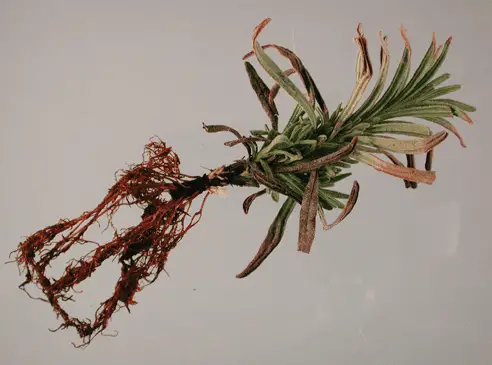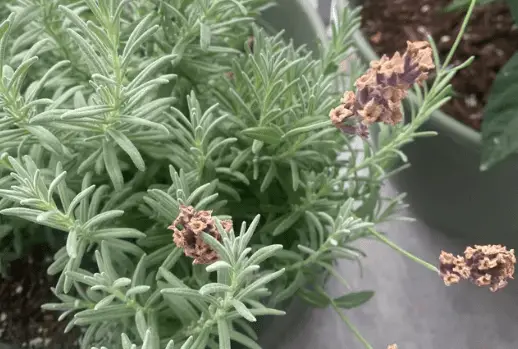Lavender is a popular herb that is used in many different ways. It has a long history of use for medicinal purposes, and it is also used in aromatherapy and as a flavoring. Lavender is a hardy plant that can be grown outdoors in most climates, but it can also be grown indoors.
One of the problems with growing lavender is that it tends to turn brown if certain conditions aren’t met. In this article, we will discuss the causes of lavender turning brown, and we will offer some tips on how to prevent it from happening.
Why Is My Lavender Turning Brown?
The most likely reasons for lavender to turn brown are overwatering, pests, fungal diseases, or sun scorch. Each of these causes browning, but the specific type of browning may be different.
Each potential cause has different symptoms that can help you identify the problem. I will now go into more detail about each of these problems so that you can troubleshoot your own lavender plant.
1. Overwatering
Overwatering is probably the most common reason that lavender turns brown. Lavender is a drought-tolerant plant, and it does not like to have its roots wet for extended periods of time. If you water your lavender too often, or if you allow it to sit in water, the roots will start to rot. This will cause the leaves to turn brown and fall off.
To prevent overwatering, make sure that you are only watering your lavender when the soil is dry. Stick your finger into the soil to check, and water only when necessary. It is better to underwater than to overwater.
The soil may also need changing if it is constantly wet. Use a well-draining potting mix, and make sure that the pot has drainage holes. Lavender plants like sandy soil, so you can add some sand to the potting mix to help with drainage.
If your lavender is already turning brown from overwatering, you can try to save it by letting the soil dry out completely and then replanting it in fresh, dry soil. You will also need to check the roots to make sure that they are not rotted. If they are, you will need to trim them off before replanting.
If your lavender is turning brown and you are not sure if it is from overwatering, check for the following symptoms:
- Soil that is always wet or soggy
- Waterlogged soil that doesn’t drain well
- Lavender leaves that are wilting or yellowing
- Lavender leaves that are brown and falling off
- Lavender stems that are soft or mushy
If you see any of these symptoms, your lavender is probably getting too much water. Try to let the soil dry out, and be sure to check the roots for rot.

2. Pests
Pests can also cause lavender to turn brown. The most common pests that affect lavender are spider mites, aphids, and whiteflies. These pests suck the sap out of the leaves, which will cause them to turn yellow or brown. In severe cases, the leaves may fall off completely.
To prevent pests from damaging your lavender, you can try using a pesticide. Be sure to follow the directions on the label, and only use pesticides when necessary. You can also try using natural predators, such as ladybugs, to control pests.
If your lavender is already turning brown from pests, you can try spraying it with neem oil (Amazon link) or insecticidal soap. These products will kill the pests without harming the plant. You can also try using a strong stream of water to blast the pests off of the leaves.
If your lavender is turning brown and you are not sure if it is from pests, check for the following symptoms:
- Small insects on the leaves
- Yellow or brown leaves
- Leaves that are being eaten
- Sticky residue on the leaves
- Holes in the leaves
If you see any of these symptoms, your lavender may be infested with pests, so be sure to check for insects. You can try using a pesticide, neem oil, or insecticidal soap to get rid of the pests.
3. Fungal Disease
Another potential cause of lavender turning brown is a fungal disease. The most common fungal diseases that affect lavender are powdery mildew and shab disease. These diseases cause the plant to turn brown and die.
To prevent fungal diseases, you can try using a fungicide. Be sure to follow the directions on the label, and only use fungicides when necessary. You can also try to grow your lavender in an area with good air circulation to prevent the fungus from taking hold.
Lavender is from arid climates and does not like humid conditions. If your lavender is turning brown and you are not sure if it is from a fungal disease, check for the following symptoms:
- White or gray powder on the leaves
- Brown spots on the leaves
- Leaves that are wilting or yellowing
- Leaves that are brown and falling off
If you see any of these symptoms, your lavender may have a fungal disease. Use a fungicide to get rid of fungal spores, and be sure to grow your lavender in an area with good air circulation.

4. Sun Scorch
Finally, another potential cause of lavender turning brown is sun scorch. Sun scorch is a condition that occurs when the leaves are exposed to too much direct sunlight. This can cause the leaves to turn brown and dry out.
To prevent sun scorch, you can try growing your lavender in an area with partial shade. You can also try to water the plant more frequently, and make sure that the soil is always moist.
If your lavender is already turning brown from sun scorch, you can try trimming off the affected leaves. This will help the plant to focus its energy on new growth. You can also try moving the plant to an area with more shade.
Will Brown Lavender Turn Purple Again?
No, it is unlikely that brown lavender will turn purple again. Once the leaves have turned brown, they will not change color. However, the good news is that new growth will be purple. So, if you tackle the original problem (too much sun, pests, etc.), you should see new purple growth during the growing season.
Should I Prune My Brown Lavender?
I only recommend pruning brown lavender plants when absolutely necessary. If more than 50% of the plant is brown, you can try pruning it back to encourage new growth. However, if less than 50% of the plant is brown, I would not recommend pruning it.
Pruning lavenders with a fungal disease can also be a good idea, as this will prevent the disease from spreading. However, be sure to disinfect your pruning tools before and after use to prevent contamination.
Conclusion
Lavender is a beautiful plant that can add color and fragrance to your garden. However, sometimes lavender will turn brown for no apparent reason. If this happens, don’t despair! There are several things you can do to fix the problem.
I hope this article was helpful. If you have any questions, please feel free to leave a comment below. I will do my best to answer your question as soon as possible. Happy gardening!
Tim is an avid gardener from the UK. He was the founder of PlantCarer.com from 2021 to Sep 2023. He sold PlantCarer.com to Aaron. He has since started his own business called Seed To Supper, which provides new gardeners all the materials you need in a box (pots, seeds, compost and instructions) to grow your own delicious and nutritious vegetables and herbs from start to finish – no garden required.










0 Comments